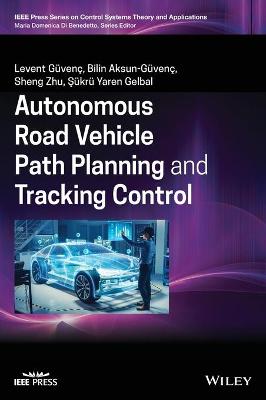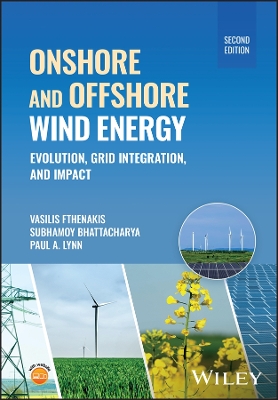Autonomous Road Vehicle Path Planning and Tracking Control
 -15%
portes grátis
-15%
portes grátis
Autonomous Road Vehicle Path Planning and Tracking Control
Zhu, Sheng; Gelbal, Sukru Yaren; Aksun-Guvenc, Bilin; Guvenc, Levent
John Wiley & Sons Inc
01/2022
256
Dura
Inglês
9781119747949
15 a 20 dias
692
Descrição não disponível.
Author biographies
Preface
Abbreviations
Chapter 1. Introduction 1
1.1 Motivation and Introduction 1
1.2 History of Automated Driving 4
1.3 ADAS to Autonomous Driving 13
1.4 Autonomous Driving Architectures 14
1.5 Cybersecurity Considerations 15
1.6 Organization and Scope of the Book 16
1.7 Chapter Summary and Concluding Remarks 16
References 16
Chapter 2. Vehicle, Path and Path Tracking Models 21
2.1 Tire Force Model 21
2.1.1 Introduction 21
2.1.2 Tire forces/moments and slip 22
2.1.3 Longitudinal tire force modeling 25
2.1.4 Lateral tire force modeling 28
2.1.5 Self-aligning moment model 30
2.1.6 Coupling of tire forces 32
2.2 Vehicle longitudinal dynamics model 37
2.3 Vehicle Lateral Dynamics Model 41
2.3.1 Geometry of cornering 41
2.3.2 Single track lateral vehicle model 43
2.3.3 Augmented single track lateral vehicle model 47
2.3.4 Linearized single track lateral vehicle model 48
2.4 Path Model 52
2.5 Pure Pursuit: Geometry Based Low Speed Path Tracking 58
2.6 Stanley Method for Path Tracking 59
2.7 Path Tracking in Reverse Driving and Parking 62
2.8 Chapter Summary and Concluding Remarks 63
References 63
Chapter 3. Simulation, Experimentation and Estimation Overview 65
3.1 Introduction to the Simulation Based Development and Evaluation Process 65
3.2 Model-in-the-Loop Simulation 68
3.2.1 Linear and Nonlinear Vehicle Simulation Models 68
3.2.2 Higher Fidelity Vehicle Simulation Models 69
3.3 Virtual Environments Used in Simulation 71
3.3.1 Road Network Creation 71
3.3.2 Driving Environment Construction 73
3.3.3 Capabilities 77
3.4 Hardware-in-the-Loop Simulation 82
3.5 Experimental Vehicle Testbeds 84
3.5.1 Unified Approach 84
3.5.2 Unified AV Functions and Sensors Library 87
3.6 Estimation 88
3.6.1 Estimation of the Effective Tire Radius 88
3.6.2 Slip Slope Method for Road Friction Coefficient Estimation 89
3.6.3 Results and Discussion 92
3.7 Chapter Summary and Concluding Remarks 97
References 97
Chapter 4. Path Description and Generation 100
4.1 Introduction 100
4.2 Discrete Waypoint Representation 100
4.3 Parametric Path Description 103
4.3.1 Clothoids 104
4.3.2 Bezier Curves 107
4.3.3 Polynomial Spline Description 108
4.4 Tracking Error Calculation 113
4.5 Conclusions 114
References 115
Chapter 5. Collision Free Path Planning 117
5.1 Introduction 117
5.2 Elastic Band Method 121
5.2.1 Path Structure 121
5.2.2 Calculation of Forces 121
5.2.3 Reaching Equilibrium Point 124
5.2.4 Selected Scenarios 125
5.2.5 Results 127
5.3 Path Planning with Minimum Curvature Variation 135
5.3.1 Optimization based on G2-quintic Splines Path Description 135
5.3.2 Reduction of Computation Cost using Lookup Tables 138
5.3.3 Geometry-based Collision-free Target Points Generation 142
5.3.4 Simulation Results 145
5.4 Model-based Trajectory Planning 148
5.4.1 Problem Formulation 148
5.4.2 Parameterized Vehicle Control 149
5.4.3 Constrained Optimization on Curvature Control 150
5.4.4 Sampling of the Longitudinal Movements 155
5.4.5 Trajectory Evaluation and Selection 157
5.4.6 Integration of Road Friction Coefficient Estimation for Safety Enhancement 159
5.4.7 Simulation Results in Complex Scenarios 162
5.5 Chapter Summary and Concluding Remarks 169
References 170
Chapter 6. Path Tracking Model Regulation 174
6.1 Introduction 174
6.2 DOB Design and Frequency Response Analysis 175
6.2.1 DOB Derivation and Loop Structure 175
6.2.2 Application Examples 178
6.2.3 Disturbance Rejection Comparison 188
6.3 Q Filter Design 188
6.4 Time Delay Performance 189
6.5 Chapter Summary and Concluding Remarks 193
References 193
Chapter 7. Robust Path Tracking Control 195
7.1 Model Predictive Control for Path Following 196
7.1.1 Formulation of linear adaptive MPC problem 196
7.1.2 Estimation of Lateral Velocity 198
7.1.3 Experimental Results 201
7.2 Design Methodology for Robust Gain-scheduling Law 204
7.2.1 Problem Formulation 204
7.2.2 Design via Optimization in Linear Matrix Inequalities form 205
7.2.3 Parameter-space Gain-scheduling Methodology 207
7.3 Robust Gain-scheduling Application to Path Tracking Control 213
7.3.1 Car Steering Model and Parameter Uncertainty 213
7.3.2 Controller Structure and Design Parameters 215
7.3.3 Application of Parameter-space Gain-scheduling 217
7.3.4 Comparative Study of LMI Design 222
7.3.5 Experimental Results and Discussions 223
7.4 Add-on Vehicle Stability Control for Autonomous Driving 227
7.4.1 Direct Yaw Moment Control Strategies 228
7.4.2 Direct Yaw Moment Distribution via Differential Braking 234
7.4.3 Simulation Results and Discussion 235
7.5 Chapter Summary and Concluding Remarks 238
References 238
Chapter 8. Summary and Conclusions 242
8.1 Summary 242
8.2 Conclusions 244
Preface
Abbreviations
Chapter 1. Introduction 1
1.1 Motivation and Introduction 1
1.2 History of Automated Driving 4
1.3 ADAS to Autonomous Driving 13
1.4 Autonomous Driving Architectures 14
1.5 Cybersecurity Considerations 15
1.6 Organization and Scope of the Book 16
1.7 Chapter Summary and Concluding Remarks 16
References 16
Chapter 2. Vehicle, Path and Path Tracking Models 21
2.1 Tire Force Model 21
2.1.1 Introduction 21
2.1.2 Tire forces/moments and slip 22
2.1.3 Longitudinal tire force modeling 25
2.1.4 Lateral tire force modeling 28
2.1.5 Self-aligning moment model 30
2.1.6 Coupling of tire forces 32
2.2 Vehicle longitudinal dynamics model 37
2.3 Vehicle Lateral Dynamics Model 41
2.3.1 Geometry of cornering 41
2.3.2 Single track lateral vehicle model 43
2.3.3 Augmented single track lateral vehicle model 47
2.3.4 Linearized single track lateral vehicle model 48
2.4 Path Model 52
2.5 Pure Pursuit: Geometry Based Low Speed Path Tracking 58
2.6 Stanley Method for Path Tracking 59
2.7 Path Tracking in Reverse Driving and Parking 62
2.8 Chapter Summary and Concluding Remarks 63
References 63
Chapter 3. Simulation, Experimentation and Estimation Overview 65
3.1 Introduction to the Simulation Based Development and Evaluation Process 65
3.2 Model-in-the-Loop Simulation 68
3.2.1 Linear and Nonlinear Vehicle Simulation Models 68
3.2.2 Higher Fidelity Vehicle Simulation Models 69
3.3 Virtual Environments Used in Simulation 71
3.3.1 Road Network Creation 71
3.3.2 Driving Environment Construction 73
3.3.3 Capabilities 77
3.4 Hardware-in-the-Loop Simulation 82
3.5 Experimental Vehicle Testbeds 84
3.5.1 Unified Approach 84
3.5.2 Unified AV Functions and Sensors Library 87
3.6 Estimation 88
3.6.1 Estimation of the Effective Tire Radius 88
3.6.2 Slip Slope Method for Road Friction Coefficient Estimation 89
3.6.3 Results and Discussion 92
3.7 Chapter Summary and Concluding Remarks 97
References 97
Chapter 4. Path Description and Generation 100
4.1 Introduction 100
4.2 Discrete Waypoint Representation 100
4.3 Parametric Path Description 103
4.3.1 Clothoids 104
4.3.2 Bezier Curves 107
4.3.3 Polynomial Spline Description 108
4.4 Tracking Error Calculation 113
4.5 Conclusions 114
References 115
Chapter 5. Collision Free Path Planning 117
5.1 Introduction 117
5.2 Elastic Band Method 121
5.2.1 Path Structure 121
5.2.2 Calculation of Forces 121
5.2.3 Reaching Equilibrium Point 124
5.2.4 Selected Scenarios 125
5.2.5 Results 127
5.3 Path Planning with Minimum Curvature Variation 135
5.3.1 Optimization based on G2-quintic Splines Path Description 135
5.3.2 Reduction of Computation Cost using Lookup Tables 138
5.3.3 Geometry-based Collision-free Target Points Generation 142
5.3.4 Simulation Results 145
5.4 Model-based Trajectory Planning 148
5.4.1 Problem Formulation 148
5.4.2 Parameterized Vehicle Control 149
5.4.3 Constrained Optimization on Curvature Control 150
5.4.4 Sampling of the Longitudinal Movements 155
5.4.5 Trajectory Evaluation and Selection 157
5.4.6 Integration of Road Friction Coefficient Estimation for Safety Enhancement 159
5.4.7 Simulation Results in Complex Scenarios 162
5.5 Chapter Summary and Concluding Remarks 169
References 170
Chapter 6. Path Tracking Model Regulation 174
6.1 Introduction 174
6.2 DOB Design and Frequency Response Analysis 175
6.2.1 DOB Derivation and Loop Structure 175
6.2.2 Application Examples 178
6.2.3 Disturbance Rejection Comparison 188
6.3 Q Filter Design 188
6.4 Time Delay Performance 189
6.5 Chapter Summary and Concluding Remarks 193
References 193
Chapter 7. Robust Path Tracking Control 195
7.1 Model Predictive Control for Path Following 196
7.1.1 Formulation of linear adaptive MPC problem 196
7.1.2 Estimation of Lateral Velocity 198
7.1.3 Experimental Results 201
7.2 Design Methodology for Robust Gain-scheduling Law 204
7.2.1 Problem Formulation 204
7.2.2 Design via Optimization in Linear Matrix Inequalities form 205
7.2.3 Parameter-space Gain-scheduling Methodology 207
7.3 Robust Gain-scheduling Application to Path Tracking Control 213
7.3.1 Car Steering Model and Parameter Uncertainty 213
7.3.2 Controller Structure and Design Parameters 215
7.3.3 Application of Parameter-space Gain-scheduling 217
7.3.4 Comparative Study of LMI Design 222
7.3.5 Experimental Results and Discussions 223
7.4 Add-on Vehicle Stability Control for Autonomous Driving 227
7.4.1 Direct Yaw Moment Control Strategies 228
7.4.2 Direct Yaw Moment Distribution via Differential Braking 234
7.4.3 Simulation Results and Discussion 235
7.5 Chapter Summary and Concluding Remarks 238
References 238
Chapter 8. Summary and Conclusions 242
8.1 Summary 242
8.2 Conclusions 244
Este título pertence ao(s) assunto(s) indicados(s). Para ver outros títulos clique no assunto desejado.
Autonomous path planning; autonomous tracking control; robust tracking control; robust path planning; collision avoidance; hardware-in-the-loop simulation; model-in-the-loop simulation; autonomous vehicle road testing; autonomous vehicle dynamics
Author biographies
Preface
Abbreviations
Chapter 1. Introduction 1
1.1 Motivation and Introduction 1
1.2 History of Automated Driving 4
1.3 ADAS to Autonomous Driving 13
1.4 Autonomous Driving Architectures 14
1.5 Cybersecurity Considerations 15
1.6 Organization and Scope of the Book 16
1.7 Chapter Summary and Concluding Remarks 16
References 16
Chapter 2. Vehicle, Path and Path Tracking Models 21
2.1 Tire Force Model 21
2.1.1 Introduction 21
2.1.2 Tire forces/moments and slip 22
2.1.3 Longitudinal tire force modeling 25
2.1.4 Lateral tire force modeling 28
2.1.5 Self-aligning moment model 30
2.1.6 Coupling of tire forces 32
2.2 Vehicle longitudinal dynamics model 37
2.3 Vehicle Lateral Dynamics Model 41
2.3.1 Geometry of cornering 41
2.3.2 Single track lateral vehicle model 43
2.3.3 Augmented single track lateral vehicle model 47
2.3.4 Linearized single track lateral vehicle model 48
2.4 Path Model 52
2.5 Pure Pursuit: Geometry Based Low Speed Path Tracking 58
2.6 Stanley Method for Path Tracking 59
2.7 Path Tracking in Reverse Driving and Parking 62
2.8 Chapter Summary and Concluding Remarks 63
References 63
Chapter 3. Simulation, Experimentation and Estimation Overview 65
3.1 Introduction to the Simulation Based Development and Evaluation Process 65
3.2 Model-in-the-Loop Simulation 68
3.2.1 Linear and Nonlinear Vehicle Simulation Models 68
3.2.2 Higher Fidelity Vehicle Simulation Models 69
3.3 Virtual Environments Used in Simulation 71
3.3.1 Road Network Creation 71
3.3.2 Driving Environment Construction 73
3.3.3 Capabilities 77
3.4 Hardware-in-the-Loop Simulation 82
3.5 Experimental Vehicle Testbeds 84
3.5.1 Unified Approach 84
3.5.2 Unified AV Functions and Sensors Library 87
3.6 Estimation 88
3.6.1 Estimation of the Effective Tire Radius 88
3.6.2 Slip Slope Method for Road Friction Coefficient Estimation 89
3.6.3 Results and Discussion 92
3.7 Chapter Summary and Concluding Remarks 97
References 97
Chapter 4. Path Description and Generation 100
4.1 Introduction 100
4.2 Discrete Waypoint Representation 100
4.3 Parametric Path Description 103
4.3.1 Clothoids 104
4.3.2 Bezier Curves 107
4.3.3 Polynomial Spline Description 108
4.4 Tracking Error Calculation 113
4.5 Conclusions 114
References 115
Chapter 5. Collision Free Path Planning 117
5.1 Introduction 117
5.2 Elastic Band Method 121
5.2.1 Path Structure 121
5.2.2 Calculation of Forces 121
5.2.3 Reaching Equilibrium Point 124
5.2.4 Selected Scenarios 125
5.2.5 Results 127
5.3 Path Planning with Minimum Curvature Variation 135
5.3.1 Optimization based on G2-quintic Splines Path Description 135
5.3.2 Reduction of Computation Cost using Lookup Tables 138
5.3.3 Geometry-based Collision-free Target Points Generation 142
5.3.4 Simulation Results 145
5.4 Model-based Trajectory Planning 148
5.4.1 Problem Formulation 148
5.4.2 Parameterized Vehicle Control 149
5.4.3 Constrained Optimization on Curvature Control 150
5.4.4 Sampling of the Longitudinal Movements 155
5.4.5 Trajectory Evaluation and Selection 157
5.4.6 Integration of Road Friction Coefficient Estimation for Safety Enhancement 159
5.4.7 Simulation Results in Complex Scenarios 162
5.5 Chapter Summary and Concluding Remarks 169
References 170
Chapter 6. Path Tracking Model Regulation 174
6.1 Introduction 174
6.2 DOB Design and Frequency Response Analysis 175
6.2.1 DOB Derivation and Loop Structure 175
6.2.2 Application Examples 178
6.2.3 Disturbance Rejection Comparison 188
6.3 Q Filter Design 188
6.4 Time Delay Performance 189
6.5 Chapter Summary and Concluding Remarks 193
References 193
Chapter 7. Robust Path Tracking Control 195
7.1 Model Predictive Control for Path Following 196
7.1.1 Formulation of linear adaptive MPC problem 196
7.1.2 Estimation of Lateral Velocity 198
7.1.3 Experimental Results 201
7.2 Design Methodology for Robust Gain-scheduling Law 204
7.2.1 Problem Formulation 204
7.2.2 Design via Optimization in Linear Matrix Inequalities form 205
7.2.3 Parameter-space Gain-scheduling Methodology 207
7.3 Robust Gain-scheduling Application to Path Tracking Control 213
7.3.1 Car Steering Model and Parameter Uncertainty 213
7.3.2 Controller Structure and Design Parameters 215
7.3.3 Application of Parameter-space Gain-scheduling 217
7.3.4 Comparative Study of LMI Design 222
7.3.5 Experimental Results and Discussions 223
7.4 Add-on Vehicle Stability Control for Autonomous Driving 227
7.4.1 Direct Yaw Moment Control Strategies 228
7.4.2 Direct Yaw Moment Distribution via Differential Braking 234
7.4.3 Simulation Results and Discussion 235
7.5 Chapter Summary and Concluding Remarks 238
References 238
Chapter 8. Summary and Conclusions 242
8.1 Summary 242
8.2 Conclusions 244
Preface
Abbreviations
Chapter 1. Introduction 1
1.1 Motivation and Introduction 1
1.2 History of Automated Driving 4
1.3 ADAS to Autonomous Driving 13
1.4 Autonomous Driving Architectures 14
1.5 Cybersecurity Considerations 15
1.6 Organization and Scope of the Book 16
1.7 Chapter Summary and Concluding Remarks 16
References 16
Chapter 2. Vehicle, Path and Path Tracking Models 21
2.1 Tire Force Model 21
2.1.1 Introduction 21
2.1.2 Tire forces/moments and slip 22
2.1.3 Longitudinal tire force modeling 25
2.1.4 Lateral tire force modeling 28
2.1.5 Self-aligning moment model 30
2.1.6 Coupling of tire forces 32
2.2 Vehicle longitudinal dynamics model 37
2.3 Vehicle Lateral Dynamics Model 41
2.3.1 Geometry of cornering 41
2.3.2 Single track lateral vehicle model 43
2.3.3 Augmented single track lateral vehicle model 47
2.3.4 Linearized single track lateral vehicle model 48
2.4 Path Model 52
2.5 Pure Pursuit: Geometry Based Low Speed Path Tracking 58
2.6 Stanley Method for Path Tracking 59
2.7 Path Tracking in Reverse Driving and Parking 62
2.8 Chapter Summary and Concluding Remarks 63
References 63
Chapter 3. Simulation, Experimentation and Estimation Overview 65
3.1 Introduction to the Simulation Based Development and Evaluation Process 65
3.2 Model-in-the-Loop Simulation 68
3.2.1 Linear and Nonlinear Vehicle Simulation Models 68
3.2.2 Higher Fidelity Vehicle Simulation Models 69
3.3 Virtual Environments Used in Simulation 71
3.3.1 Road Network Creation 71
3.3.2 Driving Environment Construction 73
3.3.3 Capabilities 77
3.4 Hardware-in-the-Loop Simulation 82
3.5 Experimental Vehicle Testbeds 84
3.5.1 Unified Approach 84
3.5.2 Unified AV Functions and Sensors Library 87
3.6 Estimation 88
3.6.1 Estimation of the Effective Tire Radius 88
3.6.2 Slip Slope Method for Road Friction Coefficient Estimation 89
3.6.3 Results and Discussion 92
3.7 Chapter Summary and Concluding Remarks 97
References 97
Chapter 4. Path Description and Generation 100
4.1 Introduction 100
4.2 Discrete Waypoint Representation 100
4.3 Parametric Path Description 103
4.3.1 Clothoids 104
4.3.2 Bezier Curves 107
4.3.3 Polynomial Spline Description 108
4.4 Tracking Error Calculation 113
4.5 Conclusions 114
References 115
Chapter 5. Collision Free Path Planning 117
5.1 Introduction 117
5.2 Elastic Band Method 121
5.2.1 Path Structure 121
5.2.2 Calculation of Forces 121
5.2.3 Reaching Equilibrium Point 124
5.2.4 Selected Scenarios 125
5.2.5 Results 127
5.3 Path Planning with Minimum Curvature Variation 135
5.3.1 Optimization based on G2-quintic Splines Path Description 135
5.3.2 Reduction of Computation Cost using Lookup Tables 138
5.3.3 Geometry-based Collision-free Target Points Generation 142
5.3.4 Simulation Results 145
5.4 Model-based Trajectory Planning 148
5.4.1 Problem Formulation 148
5.4.2 Parameterized Vehicle Control 149
5.4.3 Constrained Optimization on Curvature Control 150
5.4.4 Sampling of the Longitudinal Movements 155
5.4.5 Trajectory Evaluation and Selection 157
5.4.6 Integration of Road Friction Coefficient Estimation for Safety Enhancement 159
5.4.7 Simulation Results in Complex Scenarios 162
5.5 Chapter Summary and Concluding Remarks 169
References 170
Chapter 6. Path Tracking Model Regulation 174
6.1 Introduction 174
6.2 DOB Design and Frequency Response Analysis 175
6.2.1 DOB Derivation and Loop Structure 175
6.2.2 Application Examples 178
6.2.3 Disturbance Rejection Comparison 188
6.3 Q Filter Design 188
6.4 Time Delay Performance 189
6.5 Chapter Summary and Concluding Remarks 193
References 193
Chapter 7. Robust Path Tracking Control 195
7.1 Model Predictive Control for Path Following 196
7.1.1 Formulation of linear adaptive MPC problem 196
7.1.2 Estimation of Lateral Velocity 198
7.1.3 Experimental Results 201
7.2 Design Methodology for Robust Gain-scheduling Law 204
7.2.1 Problem Formulation 204
7.2.2 Design via Optimization in Linear Matrix Inequalities form 205
7.2.3 Parameter-space Gain-scheduling Methodology 207
7.3 Robust Gain-scheduling Application to Path Tracking Control 213
7.3.1 Car Steering Model and Parameter Uncertainty 213
7.3.2 Controller Structure and Design Parameters 215
7.3.3 Application of Parameter-space Gain-scheduling 217
7.3.4 Comparative Study of LMI Design 222
7.3.5 Experimental Results and Discussions 223
7.4 Add-on Vehicle Stability Control for Autonomous Driving 227
7.4.1 Direct Yaw Moment Control Strategies 228
7.4.2 Direct Yaw Moment Distribution via Differential Braking 234
7.4.3 Simulation Results and Discussion 235
7.5 Chapter Summary and Concluding Remarks 238
References 238
Chapter 8. Summary and Conclusions 242
8.1 Summary 242
8.2 Conclusions 244
Este título pertence ao(s) assunto(s) indicados(s). Para ver outros títulos clique no assunto desejado.







